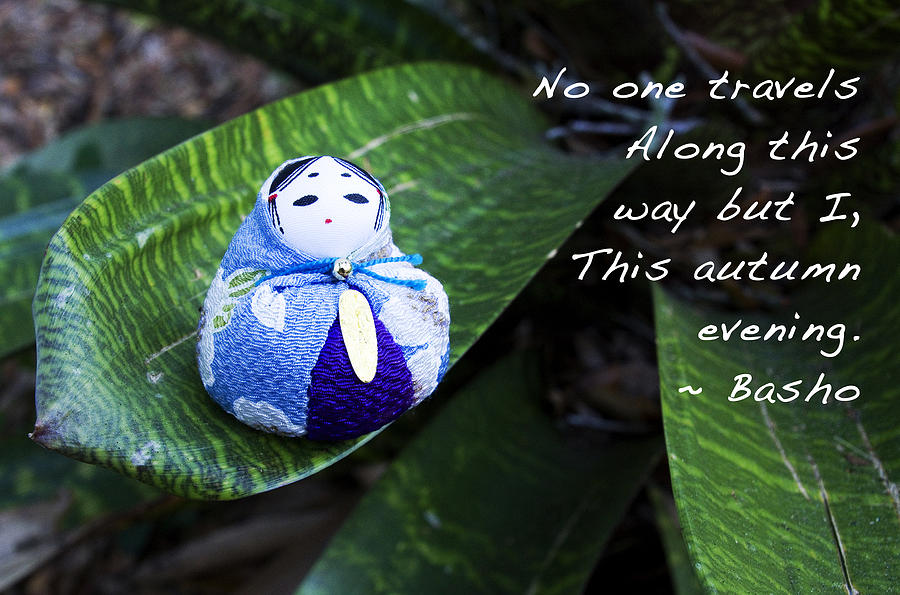
In late 1680, the 36 year old Matsuo Basho left Edo. Ogi, 荻 a Japanese plume grass that grows in marshy areas. Silvergrass Matsuo Basho, Fukagawa, Spring 1681

He once told me that he had written the following poem on the rock of his hermitage with the charcoal he had made from pine. … The priest Buccho used to live in isolation in the mountains behind the temple. With charcoal made from burnt pine, and with a touch of wry humor, Buccho had written about this about the hut: He was Basho’s Zen master and teacher from Edo. The purpose of his visit was not the temple itself, but the abandoned hut of the poet Buccho.

Leaving Kurobane, Basho and Sora walked seven miles into the mountains to visit Unganji temple, known for the practice of Zen meditation. yaburazu, a woodpecker can’t shake the serenity of this place June, 1689, Togachi prefecture Yaburazu, やぶらず, can’t shake, disturb, meaning to break Buccho’s meditation. Kitsutsuki, 木啄も, woodpecker using kanji (Chinese) characters. Kitsutsuki mo io wa yaburazu natsukodachi Oku no Hosomichi, Matsuo Basho, June 1689 Rain or shine, there is always something to write about. Buccho would gladly leave his hut, but it won’t stop raining. A woodpecker can shake a tree but not Buccho’s hut. The following poem would indicate that Saiygo joined in the conversation about long parted lovers.Īnybody was waiting? Saiygo, Japanese poet, Buddhist priest, 12th c. Waga yado wa/ michi mo naki made/ arenikeri/ tsurenaki hito o/ matsu to seshi ma ni Sōjō Henjō 僧正遍照, Japanese poet, Buddhist priest, 9th c. Mukashi mishi/ imo ga kakine wa/ arenikeri/ tsubana majiri no/ sumire nomi shite 100 Poems in Emperor Horikawa’s Collection, 11th c.Ī similar but earlier poem by the poet Sōjō Henjō 僧正遍照, Saiygo copied this one down from the Emperor Horikawa’s collection of poetry. In some cases it can be a peaceful refuge, in the following cases a unending lonely nightmare. Memory is fundamentally remembering what once mattered - Be it happy or sad. The Japanese lunar month was about a month earlier than our modern calendar. Monjin, 門 ()人, borrowed from the Chinese, meaning a disciple, follower, pupil, or student. Hamaguri no / futami ni wakare / yuku aki zo Oku no Hosomichi, last entry, Matsuo Basho, 1689 When clams split in two, autumn is passing On the 6th day of the 9th lunar month, Basho sets off by boat, “I am going to Ise to visit the Grand Shrine.” The 21st day of the 8th lunar month, arrived Ogaki. Combined, 由 (yu) meaning “reason” with 貴 (ki), it can mean it a “good reason” to stop. Yuki may mean happiness, 幸 (yuki) or snow, 雪. If one plays word games then consider this.

The victory of Tokugawa Ieyasu eventually led to the Tokugawa Shogunate and the beginning of the Edo Period.īasho’s only hint as to why the journey ended here is in closing haiku - yuki aki zo, autumn is passing by. On the 15th day of the 9th month, the Battle of Sekigahara (関ヶ原の戦い) took place in western Mino Province. If there is a historical reason for chosing this spot, it is this. Ogaki is in Gifu Prefecture (then Mino Province), west of Nagoya. The final stop of Oku no Hosomichi, the Journey to the Northern Interior. He had completed his journey of northern Japan, Oku no Hosomichi - How noble and precious, he who doesn’t think, “life is fleeting,” when seeing a flash of lightning.Ī drop of dew in the morning, a bubble in a stream,Ī flickering lamp, an illusion, a phantom, a dream… Matsuo Basho in 1690, at the age of 47 with but three years to live. Inazuma (稲妻, a flash of lightning) ni (with) satora (さとら, enlightened, understanding, one realizes) nu (ぬ, not) hito (人, people, one person) no (の, possessive) tattosa (貴さ, noble and precious). Gypsum Hills, KansasĪs day turned to evening, and evening to darkness, my wife and I were entertained by a show of lightning to the north. In the Gypsum Hills between Meade and Medicine Lodge, the route featured flat mesas, long canyons and arroyos, red rolling hills, and vast empty stretches with no living beings. Mid-September, 2022, crossing Kansas along US 160, coming home from Las Vegas, New Mexico. Inazuma ni / satoranu hito no / tattosa yo Matsuo Basho, 1690 Figuratively and Literally A flash of lightning in a September cloud, a Zen reflection on the impermanence of life, but to those don’t know, a precious thing to behold.


 0 kommentar(er)
0 kommentar(er)
